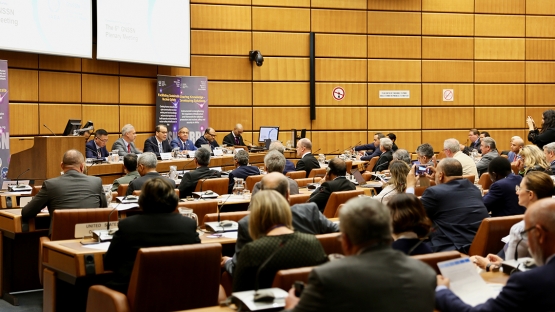A new, consolidated approach developed by the IAEA will streamline the Agency’s support to countries in the field of nuclear safety. The Consolidated Plan for Safety was presented today during the Sixth Global Nuclear Safety and Security Network (GNSSN) Plenary Meeting, on the sidelines of the IAEA 63rd General Conference.
The Consolidated Plan for Safety, or CPS, will help the IAEA and its Member States address challenges more efficiently and comprehensively, consolidating efforts and stakeholders that, in the past, coexisted separately.
“We cannot stress enough how important safety and security are. [The plan] means our activities to support a country in nuclear, radiation, transport, waste safety and emergency preparedness and response are coherent and consistent, and that they complement one another,” said IAEA Acting Director General Cornel Feruta at the event. “National plans […] will help countries and the Agency to measure progress in developing resilient national infrastructure for safety.”
The CPS will be developed by national stakeholders, with the assistance of IAEA experts, and will be tailored for each country — in line with a methodology already in place in nuclear security, where each country has an Integrated Nuclear Security Support Plan, or INSSP, which forms the basis of IAEA assistance. The CPS, based on the IAEA’s Safety Standards, brings different fields of activity within safety into one.
“In the fields of safety and security, there are areas that countries work on separately, such as regulations and inspections, when they could actually be working together in a synergetic way,” said Khammar Mrabit, Director General of Morocco’s Nuclear and Radiological Safety and Security Agency and GNSSN Chairman of the Plenary Meeting. “By further coordinating our efforts, we can use and optimize the same resources, both financial and human, to improve our results and ultimately safety and security. We are moving in the right direction.”
IAEA experts and Member State representatives discussed achievements reached over the years and compared notes on current challenges in nuclear safety. They said the aim was to use the CPS to reassess the way things are done currently and optimize the impact of IAEA assistance, building on past models, such as the Model Project and the Thematic Safety Areas approach.
“The Plan takes everything we learned and, utilizing our experience, drafts the way forward to enhance safety worldwide amidst emerging challenges,” said Faizan Mansoor, Executive Member of the Pakistan Nuclear Regulatory Authority (PNRA).
The plan allows for crucial optimization by combining — in a single concept — efforts carried out using the Agency’s regular budget, extra-budgetary and technical cooperation resources, as well as national resources, said Gustavo Caruso, Director of the IAEA’s Office of Safety and Security Coordination.
“This is an important initiative that will help us better assist Member States as they develop a robust safety infrastructure,” Caruso said, adding that, “as always in nuclear safety, commitment and leadership are key factors for success.”
So far, 12 pilot countries have been selected to validate the CPS concept in the coming months.





